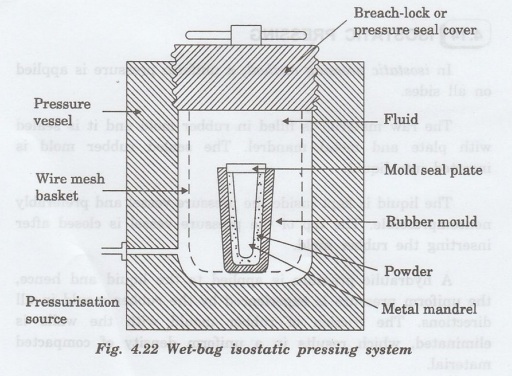Physics For Civil Engineering: Unit IV: New Engineering Materials
Isostatic Pressing
Operation, Different methods
In isostatic pressing method, a uniform pressure is applied on all sides. The raw material is filled in rubber mold and it is sealed with plate and metal mandrel. The sealed rubber mold is inserted into liquid.
ISOSTATIC PRESSING
In isostatic pressing method, a uniform
pressure is applied on all sides.
The
raw material is filled in rubber mold and it is sealed with plate and metal mandrel.
The sealed rubber mold is inserted into liquid.
The liquid is kept inside the pressure
vessel and preferably noncompressible. The top of the pressure vessel is closed
after inserting the rubber mold.
A
hydraulic pressure is applied to the liquid and hence, the uniform pressure is
experienced by the rubber mould in all directions. The friction of rubber mould
with the walls is eliminated, which results in a uniform density of compacted
material.
By
removing the pressure, the rubber mould is taken out. The compacted material is
removed by removing the mould sealed plate and metal mandrel. bild
The
compacted materials are then subjected to densification resulting in more
uniform shrinkage with less wrapping and cracking.
There
are two different methods of isostatic pressing
(i) wet-bag
(ii)
dry-bag processing
In wet-bag processing method, raw
material is filled in flexible rubber mold, sealed and then poured
isostatically. The experimental set-up is shown in Fig. 4.22. The pressure
applied in laboratory experiment process ranges from 35 to 1380 MPa.

However,
in industry, the production units normally operate at a pressure of 400 MPa or
even less.
This
method is widely used for production of variety of products and sizes. The main
disadvantages of this method are long cycle time, high labour requirements and
low production rates.
Physics For Civil Engineering: Unit IV: New Engineering Materials : Tag: : Operation, Different methods - Isostatic Pressing
Related Topics
Related Subjects
Physics for Civil Engineering
PH3201 2021 Regulation | 2nd Semester Civil Dept 2021 Regulation
